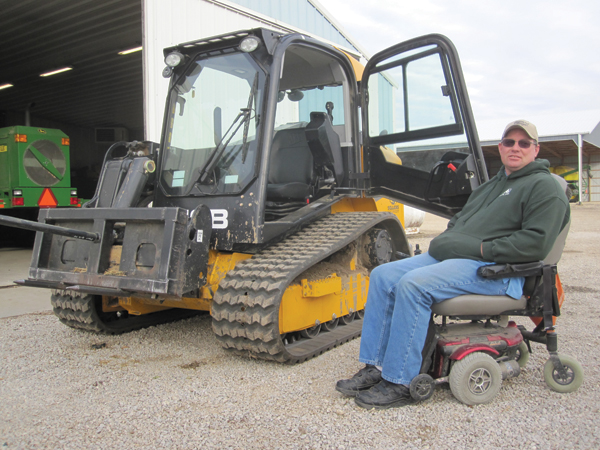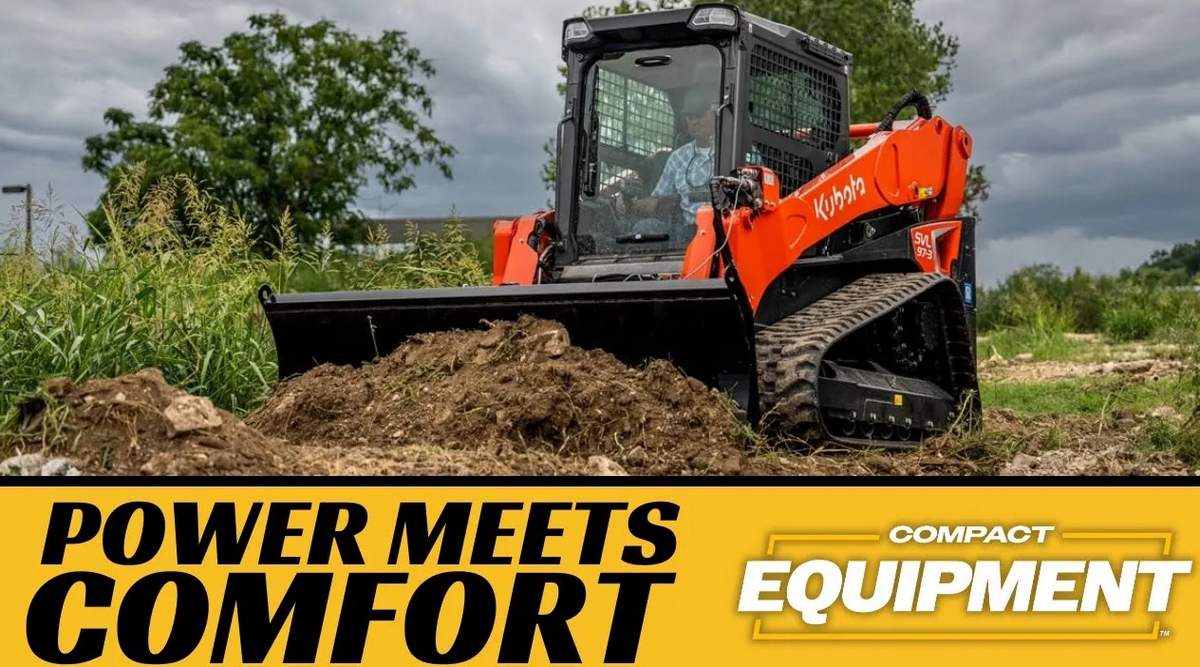Back on Track
If you were asked to prepare a list of trade professions that use the most diverse range of equipment on the job, which ones would you choose? Certainly farming would appear on most people’s lists. Not only do farmers use tractors, combines, plows and disks to plant and harvest crops, most must also use a wide variety of equipment to maintain their large properties. This often means using a skid steer to clear long driveways after a snowstorm or a mini excavator to clear a drainage ditch that’s clogged with sediment and weeds. Some farmers also use telescopic handlers to load hay bales over the tall sides of their farm trucks and four-wheel, all-terrain utility vehicles to check on livestock in rough pastures.

Unfortunately, farming can also be a dangerous profession. Long hours spent outdoors, high stress levels and the need to operate various types of potentially dangerous heavy equipment, make farming a very demanding career. It requires self-motivation, scientific knowledge, mechanical skills and physical endurance. Running a farm requires the ability to traverse relatively long distances, navigate rough terrain, operate machinery and work in often uncomfortable conditions. Considering all that: How does a farmer stay productive when he or she is faced with a life-altering injury or degenerative disease?
A New Perspective
Chad Came encountered that exact question when he was diagnosed with multiple sclerosis at the age of 23. His whole life revolved around the large Salina, Kansas, farm that he shares with his mother, brother and sister. Now 37, Came’s condition has slowly worsened to the point where he can now no longer walk, but still maintains use of his hands.
“Winters are the worst,” Came says. “Over the years, it’s been increasingly difficult for me to find ways to stay busy.”
Mark Johnson, sales representative for Sellers Equipment in Salina, has known the Came family for years. He has witnessed Chad’s life change as his disease progressed.
“Chad was used to doing anything he wanted to do,” Johnson says. “He’s a third generation farmer who lost his dad two years ago. Now, Chad, his mom, his two siblings, their spouses and their offspring have to keep the farm going. Unfortunately, multiple sclerosis has slowly but surely taken Chad’s legs quite literally out from under him.”
Came is just one example of the many farmers who’ve had to adapt their work habits due to physical limitations. According to a study published by the Journal of Agromedicine, it’s estimated that between 1.04 million to 2.23 million individuals working in agriculture in the United States are affected by a disability. That’s a staggering number when you consider that only 17.1 percent of the U.S. population lives in or near farming communities. The 2007 U.S. Census of Agriculture found that the average age of a farmer in the United States is 57.1, which means that many farmers are disabled due to age-related issues such as arthritis, hearing impairment, spinal conditions and respiratory diseases. Others, like Came, suffer from developmental diseases like cerebral palsy, autism or multiple sclerosis. Still others have experienced accidents on the job, resulting in amputations or traumatic brain injuries.
Regardless of the reasons for their physical challenges, disabled farmers have to find new ways to stay productive on the farm or abandon their farming lifestyle altogether. However, anyone who’s known someone fully engaged in farming can understand how challenging this proposition is. Farmers are known for their strong work ethic and extreme independence. It’s often quite difficult for them to accept help or ask others for assistance.
Life-Changing Equipment
Fortunately, agricultural machinery and heavy equipment manufacturers are now designing machines that make it possible for disabled individuals like Came to continue contributing to the livelihood of their farms. In the summer of 2011, Came, his two sons aged 10 and 12 and his brother visited Mark Johnson and the rest of the staff at Sellers Equipment during a trip into Salina. During that visit, a unique machine caught the eye of Came’s 12 year old — a JCB 320T compact track loader with a unique side-entry door.

“We were already familiar with skid steers and track loaders,” Came recalls. “We actually owned a skid steer from another manufacturer at one time. It was a perfectly good machine, but we got rid of it because I wasn’t able to even get inside. But when my son saw the JCB machine with its side door, he said, ‘Dad, I bet you could get in and out of that one.’”
JCB designs each of its skid steer and compact track loader models with a single loader arm — a design the manufacturer calls its “Powerboom.” All other skid steer and track loader brands in the marketplace today (besides Volvo, which shares the Powerboom design) have conventional two-armed loaders, making it necessary for operators to climb over the arm and any attachments to enter the machines through their front windows. JCB’s Powerboom attaches only to the right side of the machine, leaving the left side able to accommodate the side-entry door that makes it possible for Came to enter and exit the machine.
“I remember that Chad’s brother was particularly excited when he saw this machine,” Johnson recalls. “He and the rest of the Came family want Chad to be as productive as possible around the farm, but it’s hard to find things for him to do. They immediately recognized the fact that Chad could use the 320T track loader to accomplish numerous tasks around the farm.”
While these days, skid steer loaders and compact track loaders are used for a wide variety of tasks from landscaping to construction, the machines actually got their start in an agricultural setting. The first skid steers developed in the 1950s in the upper Midwest and made it possible for farmers to easily access low-ceilinged facilities on their properties like poultry houses. As the owners of these skid steers began to recognize their versatility, they began using the machines for many other tasks.
A Better Future
After Came and his family expressed great interest in the 320T, Johnson offered to bring the machine out to the farm for a trial run. “They chose to investigate the tracked model rather than the wheeled version because they thought it would be easier for Chad to get inside,” Johnson explains. “He could slide himself from his wheelchair into a seated position on the track and then slide into the cab.”
From the minute Came entered the cab, he was hooked. In fact, he was hesitant to let it out of his sight. “The minute we brought the machine out, he said it wasn’t going any further,” Johnson laughs. “He didn’t want us to take it away. The Cames signed the sales order subject to getting the machine back following a few other demos we had scheduled.”
Not only is Came able to get into the cab of his new track loader with ease, he is able to operate it smoothly and for long periods of time without fatigue. While earlier skid steers and track loaders employed simple mechanical linkages and longer lever movements, today’s machines typically feature hydraulic servo controls that require less effort on the part of the operator while providing more precise control.
“I love how easy it is to use the hand controls,” Came says. “Every day I run it, I get better with it. I also fell in love with the tracks because they’re so much better on rough terrain than wheels.”
Came is looking forward to using his compact track loader for all kinds of tasks around the farm all year round, approximately four hours per day. With a 3,200-lb operating capacity, 92-hp engine and 30 different attachments available, the 320T has the power and flexibility he needs to clear snow, mow, haul hay and manure and load trucks. Came says his next attachment purchase will be a tree saw for trimming trees during the long winter months when he used to spend far too much time indoors for his liking.
According to Johnson, Came’s story has really struck a chord with many people.
“The day after delivering the machine, I stopped back at the farm to check on Chad,” Johnson says. “He said ‘I just feel like I’m worth something again. This piece of machinery has given me my legs back when I’m on the farm.’ There’s no doubt in my mind that this machine has really made a difference in his life.”
Lynette Von Minden is a public relations writer with Swanson Russell, based in Lincoln, Neb.
Helping Agricultural Workers Help Themselves
The National AgrAbility Program provides assistance and support for those farm and ranch workers like Chad Came whose lives have been affected by an injury or disease. Sponsored by the U.S. Department of Agriculture (USDA), AgrAbility consists of a national project and 24 state/regional projects. Each project includes collaborative partnerships between land grant universities and various nonprofit disability services organizations. AgrAbility’s goal is to help farmers, ranchers and other agricultural workers with disabilities achieve a high quality of life, so that they, their families and their communities continue to succeed in rural America. For more information, visit www.agrability.org.




